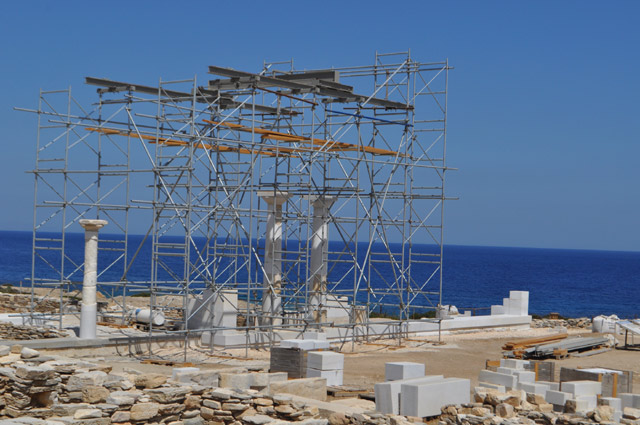Antiparos (Modern Greek: Αντίπαρος; Ancient Greek: Ὠλίαρος Oliaros) is a small island in the southern Aegean, at the heart of the Cyclades, which is less than one nautical mile (1.9 km) from Paros, the port to which it is connected with a local ferry. Saliagos island is the most ancient settlement in the Cyclades, and Despotiko, an uninhabited island in the southwest of Antiparos, is a place of great archaeological importance.
The Community of Antiparos was founded in 1914 and was promoted to a municipality in 2010 with the implementation of the Law “Kallikrates”, under the principle of “each island a municipality”. It occupies an area of 45.182 square km, including the island of Antiparos and Despotiko. It has, according to the 2011 census, 1,211 permanent residents and a density of 27 inhabitants per km². The island’s economy is based on tourism, fishing, farming and less on agriculture in the plains. It is known for its distinctive Cycladic beauty with white houses, cobbled streets and beautiful flowers that thrive in the yards of the houses. It is a popular tourist resort in the summer for Greeks and European visitors, as well as land investors from the United States.

History

The Venetian episode came to an end in 1537, when Antiparos and the rest of the Cyclades fell to the Ottomans, and it remained under Ottoman rule until the Greek War of Independence in 1821, apart from a period of the Orlov Revolt in 1770–74 when it was ruled by the Russians, who removed many of the magnificent stalactites from the cave to the Hermitage Museum in Russia.
In 1770 the French botanist Joseph Tornefort reported that Antiparos numbered 78 houses about 200 residents.
The major catastrophe was in 1794, when Kefalonians and Mani pirates arrived on the island and plundered, and kidnapped the daughter of the Venetian vice-Consul.
The Antiparians were among the first in the Cyclades to take part in the War of Independence and in 1832 officially became part of the Greek state.
During World War II, the southwestern tip of the island near the Agios George, was used as a secret submarine base, but after the war it became once more a tranquil place, though now growing as a tourist village.
Antiparos was known to the wider Greek public in 1960 and through the Greek cinema, where workshops hosted by Finos Films in the heart of the movie “Madalena” by helping to enhance its natural beauty and historical landscape. Since then, the island became a popular tourist destination for Greek and foreign tourists in the summer and the economy of the town started oriented tourism development.
Archaeology

There are extensive Neolithic remains on the island. The first excavations were those made by the traveller Theodore Bent in 1884, who opened up some 40 graves in two cemeteries. In 1889 Christos Tsountas excavated in Despotiko, revealing Cycladic cemeteries. From 1964-5 a Neolithic settlement was excavated on the island of Saliagos by Colin Renfrew and J D Evans for the British School at Athens. Stone foundations of buildings, obsidian arrowheads and pottery were found, together with a marble figurine known as the Fat lady of Saliagos.
Classical remains are concentrated on the island of Despotiko. The Isle of Antiparos was identified with ancient Prepesintho, according to the extant writings of Strabo and Pliny.
In 1959 Nikos Zafiropoulos began excavations at Zoumparia and Mantra, on the northeast coast, where they were architectural Doric temple from the ancient times, dating to 500 BC.
In 1997, the archaeologist Yiannos Kourayos began new excavations at Mantra, bringing to light some of the ancillary buildings of a sanctuary. The temple itself has not so far been discovered, though a number of architectural elements from an early Doric temple have been discovered built into later walls. The main finding so far have been an elongated building, consisting of five consecutive parallel rooms. In the southern room archaic materials of Eastern Aegean, Rhodian, Cypriot and Egyptian origin have been discovered.
Many marble sculptures were found, including two archaic kouros head, a naked male statue, part of the Archaic period perirrantiriou inscribed with the inscription “Marda anethiken”. Among the significant findings include the built-square marble altar dedicated to Hestia Isthmus of classical times and which is testimony to one of the deities worshiped in the Cyclades.
Cinema
Madalena is a 1960 Greek comedy film directed by Dinos Dimopoulos. It was entered into the 1961 Cannes Film Festival. The film won three awards in the 1st Thessaloniki Film Festival.
Suntan is a 2016 Greek drama film directed by Argyris Papadimitropoulos. It premiered at the International Film Festival Rotterdam in February and was released in Greece in March 2016, where it grossed $145,858.
Διαβάστε αυτή τη σελίδα στα:

